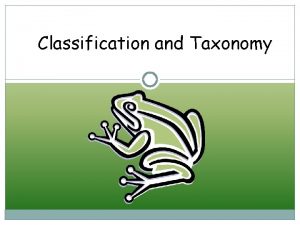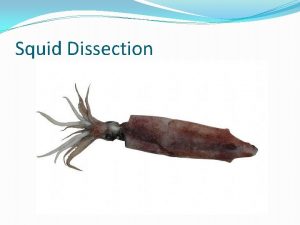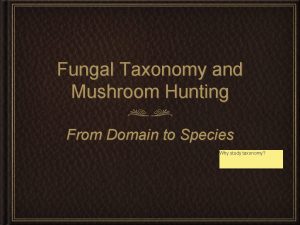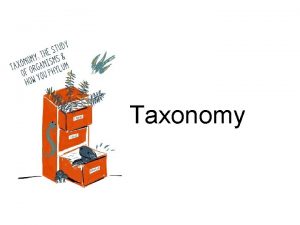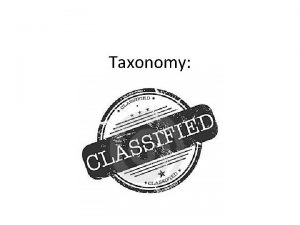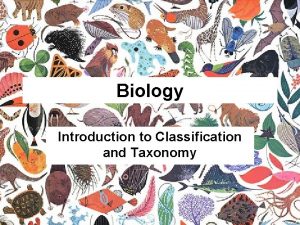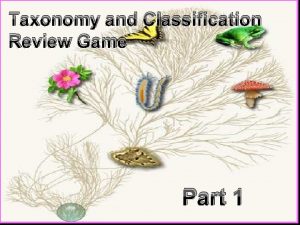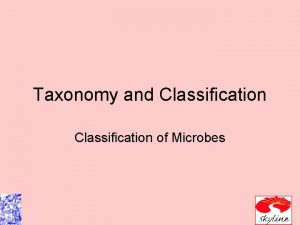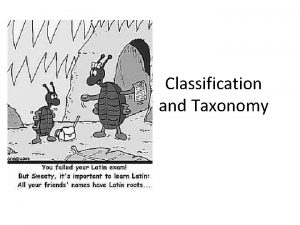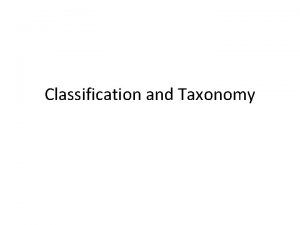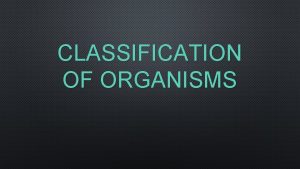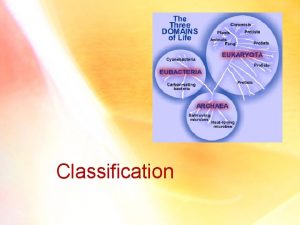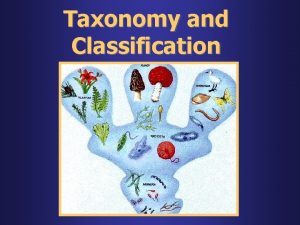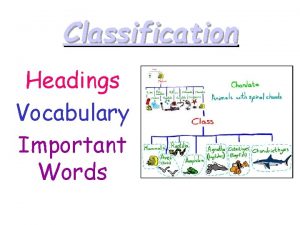Classification and Taxonomy Classification Is the process of



























- Slides: 27

Classification and Taxonomy

Classification • Is the process of separating objects into groups • Biologists use dichotomous keys to separate organisms into groups using characteristics or traits • A dichotomous key uses contrasting statements to separate organisms into two groups

Dichotomous Key • Examples of contrasting statements would be • 1 a) Things which are white • 1 b) Things which are not white

Example of a Dichotomous Key table, glass, dog, cat, tree, rose, tulip 1 a) Things which are living (go to 2) 1 b) Things which are not living (go to 6) 2 a) Things which are animals (go to 3) 2 b) Things which are not animals (go to 4) 3 a) Things which have retractable claws – cat 3 b) Things which do not have retratable claws - dog

• 4 a) Things which grow from a bulb – tulip • 4 b) Things which do not grow from a bulb (go to 5) • 5 a) Things which have thorns – rose • 5 b) Things which do not have thorns – tree • 6 a) Things with legs – table • 6 b) Things with no legs - glass

• It should be noted that a dichotomous key will always have one less number than items on the list • For practice – design a dichotomous key for the following list • Elephant, cow, horse, apple, orange, chair, box, bucket, stapler


Reason to Classify 1. To see the world in an organized way. 2. To provide a logical naming system 3. To communicate without confusion.

Carolus Linnaeus • Linnaeus was a Swedish naturalist/botanist who made an extraordinary attempt to classify all known organisms • Linnaeus published a “book” called Species Plantarum in which he listed all known plants • Linnaeus looked at the reproductive structures on plants



• Linnaeus developed a system to name organism • In the past there were many problems with the various naming systems • For example one name for a common pink carnation was • dianthus floribus solitarilis squamis calycinis subovatis brevissimis corollis crenatis

• Linnaeus developed a much more simple system • His system was based on two words • The two-name system of designating organisms is known as the binomial system

Advantages of Developing a Scientific Naming System 1. 2. 3. 4. 5. 6. Only one name for every species. One species – one name Recognized world wide. Utilizes Latin alphabet (never changes) Organized according to ancestral relationships. Major divisions in names are based on zoology, physiology, morphology and anatomy.


Binomial Nomenclature As indicated Linnaeus first invented this two name classification system: (rules) 1. First name is the Genus and is capitalized. 2. Second name is Species and is lower case. 3. The third part of the name is the last name of the individual discovering/naming it 4. Entire name must be underlined or in italics. Homo sapiens. / Homo sapiens Please note that any names with the prefix L. means that Linnaeus named it.

Classification System

7 Levels of Classification • There are seven levels of classification from general to specific 1. Kingdom 2. Phylum 3. Class 4. Order 5. Family 6. Genus 7. Species

Kingdom • There are five kingdoms of living things • A kingdom is made up for several phylum Phylum • A Phylum is made up of several classes which are related or similar Class • A class is made up of several orders which are related or similar

Order • An order is made up of several families which are related or similar Family • A family is made up of several genera (plural for genus) which are related or similar Genus • Is made up of several species which are related or similar

SPECIES A group of similar organisms which interbreed under natural conditions to produce fertile offspring



Classification Table Level of classification Name of Level Organism A Organism B Organism C 1 Kingdom Animalia 2 Phylum Chordata 3 Class Mammalia Reptilla 4 Order Carnivore Primates Crocodilla 5 Family Felidae Hominidae Crocodilla 6 Genus Felis Homo Crocodylos 7 Species domesticus sapiens niloticus CAT HUMAN Crocodile

5 Kingdom Poster Assignment Goal: to name the 5 kingdoms and state examples and characteristics of each kingdom. Using Figure 15 -10 (p 325) as a guide, identify characteristics for each kingdom and list them along with examples on a poster (11 x 17). Find and define the following on a separate sheet of paper: prokaryotes, eukaryotes, multicellular, unicellular, heterotrophs, cell wall, photosynthetic, autotrophic, producers, cell membrane, consumers, decomposers. Attach the definitions and use the terms in the appropriate place on the poster.


 The new taxonomy
The new taxonomy Biodiversity examples
Biodiversity examples Taxonomy, classification, and dichotomous keys
Taxonomy, classification, and dichotomous keys How scientific names are written
How scientific names are written Horse domain kingdom phylum
Horse domain kingdom phylum Squid kingdom
Squid kingdom Domain of mushroom
Domain of mushroom Hình ảnh bộ gõ cơ thể búng tay
Hình ảnh bộ gõ cơ thể búng tay Slidetodoc
Slidetodoc Bổ thể
Bổ thể Tỉ lệ cơ thể trẻ em
Tỉ lệ cơ thể trẻ em Gấu đi như thế nào
Gấu đi như thế nào Tư thế worms-breton
Tư thế worms-breton Alleluia hat len nguoi oi
Alleluia hat len nguoi oi Các môn thể thao bắt đầu bằng tiếng chạy
Các môn thể thao bắt đầu bằng tiếng chạy Thế nào là hệ số cao nhất
Thế nào là hệ số cao nhất Các châu lục và đại dương trên thế giới
Các châu lục và đại dương trên thế giới Công của trọng lực
Công của trọng lực Trời xanh đây là của chúng ta thể thơ
Trời xanh đây là của chúng ta thể thơ Cách giải mật thư tọa độ
Cách giải mật thư tọa độ Phép trừ bù
Phép trừ bù Phản ứng thế ankan
Phản ứng thế ankan Các châu lục và đại dương trên thế giới
Các châu lục và đại dương trên thế giới Thơ thất ngôn tứ tuyệt đường luật
Thơ thất ngôn tứ tuyệt đường luật Quá trình desamine hóa có thể tạo ra
Quá trình desamine hóa có thể tạo ra Một số thể thơ truyền thống
Một số thể thơ truyền thống Cái miệng bé xinh thế chỉ nói điều hay thôi
Cái miệng bé xinh thế chỉ nói điều hay thôi Vẽ hình chiếu vuông góc của vật thể sau
Vẽ hình chiếu vuông góc của vật thể sau



